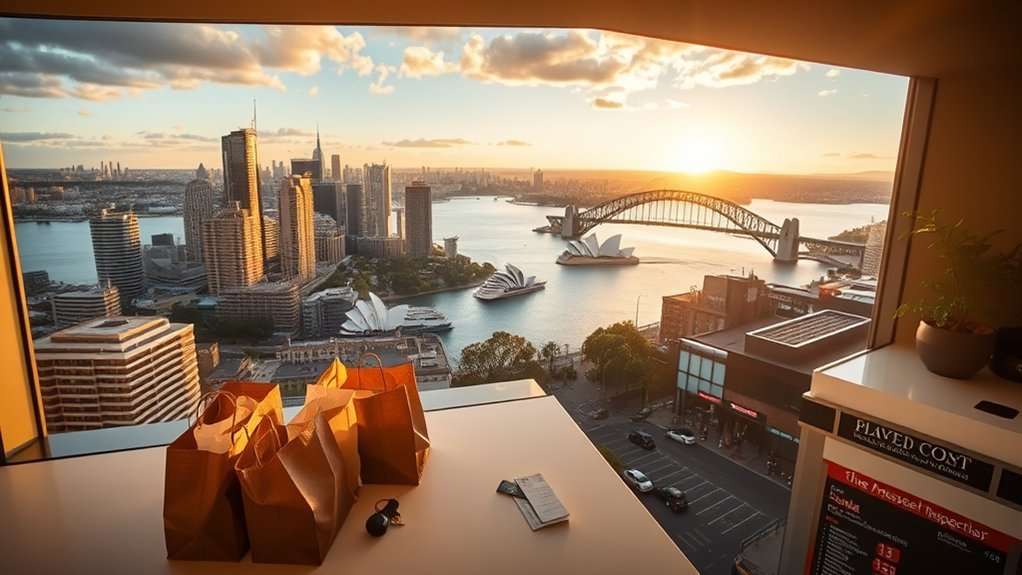You’ll typically need about A$3,890 a month as a single and roughly A$9,479 for a family of four to cover living costs in Australia, with rent usually the largest line item. Groceries range from A$550–A$700 for one and A$1,000–A$1,300 for four. Expect utilities/internet/mobile about A$427 and public‑transport passes near A$168. Costs spike in Sydney and Canberra and fall in regional centres; continue for practical breakdowns and saving strategies.
What Are the Average Living Costs by Household Type?

While exact budgets vary by city and lifestyle, recent Numbeo (2024) data show clear patterns: a single person’s average monthly outlay is about A$3,890 (A$1,654 for living expenses plus A$2,236 rent), whereas a family of four averages roughly A$9,479 (A$5,851 living expenses plus A$3,628 rent).
Recent Numbeo (2024) data: singles spend about A$3,890 monthly; families of four around A$9,479.
You’ll see that Cost of Living splits into discrete components: groceries, rent in Australia, and recurring services.
For groceries, expect roughly A$550–A$700 for a single person and A$1,000–A$1,300 for a family of four; these ranges materially affect average monthly costs.
Monthly utilities and connectivity—approximately A$303 for electricity/water/garbage, A$82 for internet and A$42 for a mobile plan—add near A$427 to household budgets for an 85m² unit.
Analytically, rent in Australia constitutes the largest single line item, but combined groceries and monthly utilities create a predictable baseline you’ll need to budget against when comparing household types.
Housing, Rent and Where You’ll Pay the Most
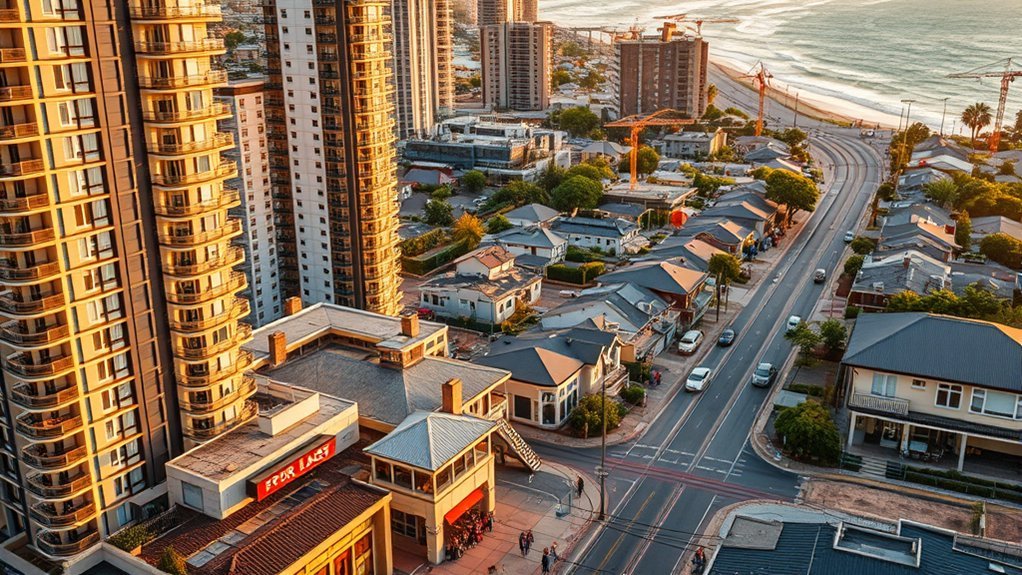
Having established how groceries and utilities form a baseline, housing quickly becomes the dominant cost driver: average city‑centre rents for a 1‑bedroom run about A$2,236 and for a 3‑bedroom about A$3,628, placing Australia among the world’s more expensive countries (Numbeo rank: 10th).
You’ll find pronounced geographic variation: Canberra and Sydney push family budgets highest (Canberra ≈ A$10,954/month for four), while regional areas such as Townsville, Bendigo and Ballarat report much lower monthly costs (≈A$1,861–A$1,977).
Market tightness in major cities has driven record‑high median rent (~A$627/week) and rising rent prices, causing many households to spend over 30% of income on housing.
Leases typically run 6–12 months, with rent paid weekly or fortnightly; expect a rental bond equal to four–six weeks’ rent lodged with a government authority and to provide ID, income proof and references.
To reduce cost you can consider shared housing, moving outside the city‑centre or relocating to regional areas where average rents are substantially lower.
Utilities, Transport and Connectivity Costs
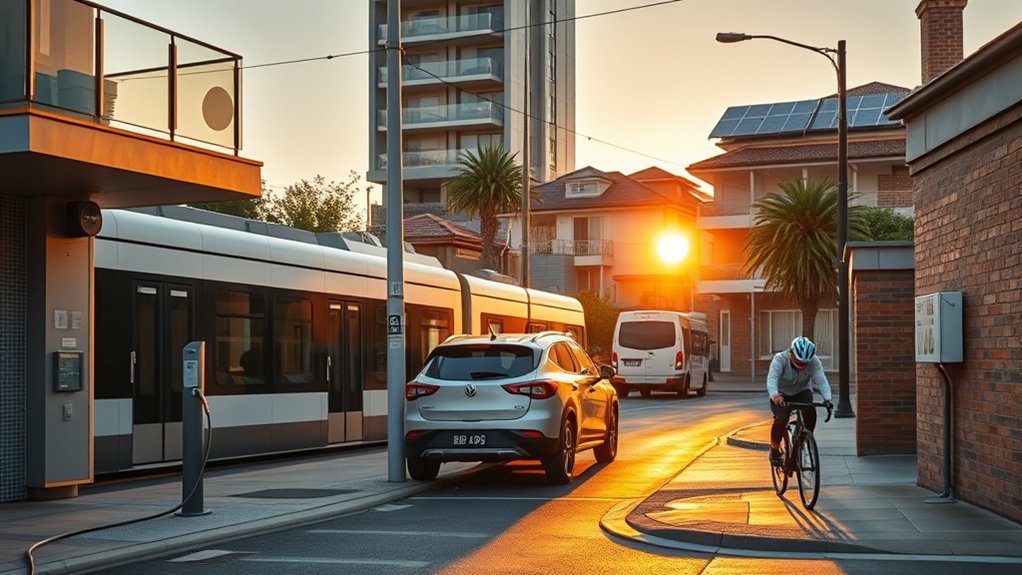
You’ll want to budget roughly A$303 per month for basic utilities in an 85 m² apartment and about A$82/month for a 60+ Mbps unlimited home internet connection.
Public transport trip costs average A$5 one‑way with monthly passes near A$168, while mobile plans range from about A$39–A$55/month for 20–40 GB or A$42 for typical 10+ GB plans.
Compare these figures with petrol at ~A$1.90/L and taxi base fares around A$6 (≈A$60/hour waiting) to determine your likely monthly transport and connectivity spend.
Utility Bills Breakdown
Break down your monthly utility and transport expenses to see where most costs sit: basic utilities for an 85 m² apartment average about A$303/month, home internet (60 Mbps+, unlimited) runs roughly A$82/month, and mobile plans with 10+ GB cost around A$42/month.
You should treat these figures as core components of living costs and use them to estimate your per month budget. Compare energy plans via Energy Made Easy, shift consumption to off‑peak hours, and select energy‑efficient appliances to reduce the monthly fee for utilities. Calculate trade-offs between driving (fuel at ~A$1.90/litre) and taxis. Prioritize fixed Australian dollars commitments (internet, mobile) when planning cash flow; variable items (electricity, fuel) respond to behavior and tariff selection.
- Itemize fixed vs variable utilities.
- Monitor monthly fee trends.
- Optimize energy plans and usage.
Public Transport Costs
While public transport often cuts the total cost of commuting, you should quantify fares and pass options to see the true savings: single local trips average about A$5 each, while monthly passes run near A$168, and fare structures vary by city smartcard (Opal, myki, go card) with time‑of‑travel and concession rules affecting cost; compare this to taxi base fares (~A$6) and rideshare surge fees, and to the full cost of driving (fuel ~A$1.90/L plus registration, insurance, tolls and parking) when deciding whether public transit, occasional rideshares, or car ownership is most economical for your travel patterns.
Analyze your weekly trip count, peak vs off‑peak travel, concession eligibility and transfer rules; a monthly pass often becomes cost‑effective beyond about 34 one‑way trips.
Mobile and Internet
How much will connectivity add to your monthly budget? You’ll typically pay about A$42 for a mobile phone plan with 10+ GB; major postpaid tiers run A$39–A$55 depending on allowance. Home internet (60+ Mbps, unlimited) averages A$82/month. Prepaid starter packs cost A$30–A$35/28 days for 10–15 GB; MVNOs can lower that. eSIM providers (Airalo, Holafly) and major carriers (Telstra, Optus, Vodafone) supply short‑term or broad‑coverage data plans.
- Compare postpaid vs prepaid: ongoing A$39–A$55 vs A$30–A$35 per 28 days.
- Budget home internet: plan A$70–A$90; average A$82/month.
- Consider transport integration: monthly pass A$168 versus pay‑as‑you‑go fares.
Food, Groceries and Eating Out
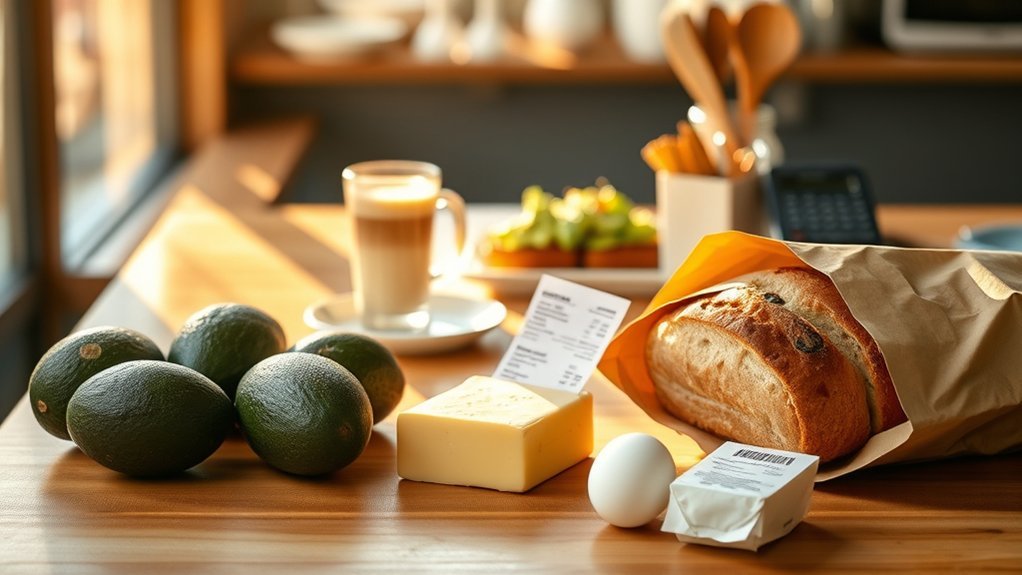
Although food costs vary by city and eating habits, you should budget roughly A$550–A$700 monthly for a single person, A$700–A$900 for a couple, and A$1,000–A$1,300 for a family of four to cover groceries alone.
You’ll set a realistic monthly grocery budget by comparing Supermarkets—Coles and Woolworths with loyalty programs—and ALDI for lower prices; Costco helps if you buy in bulk.
Typical item prices illustrate scale: a cappuccino ~A$5.30, a dozen eggs ~A$6.20, and a 0.33L soft drink ~A$3.30.
Eating out ranges from A$12–A$25 for cheap meals, ~A$15 for a McMeal, to ~A$120 for a mid‑range three‑course dinner for two.
To control spending, apply money‑saving tips: cook at home, use farmers’ markets, compare supermarket online carts, buy staples in bulk, and use price‑comparison apps like Frugl.
Monitoring receipts and adjusting shopping frequency will keep your food budget aligned with household needs.
Childcare, Education and Family Expenses
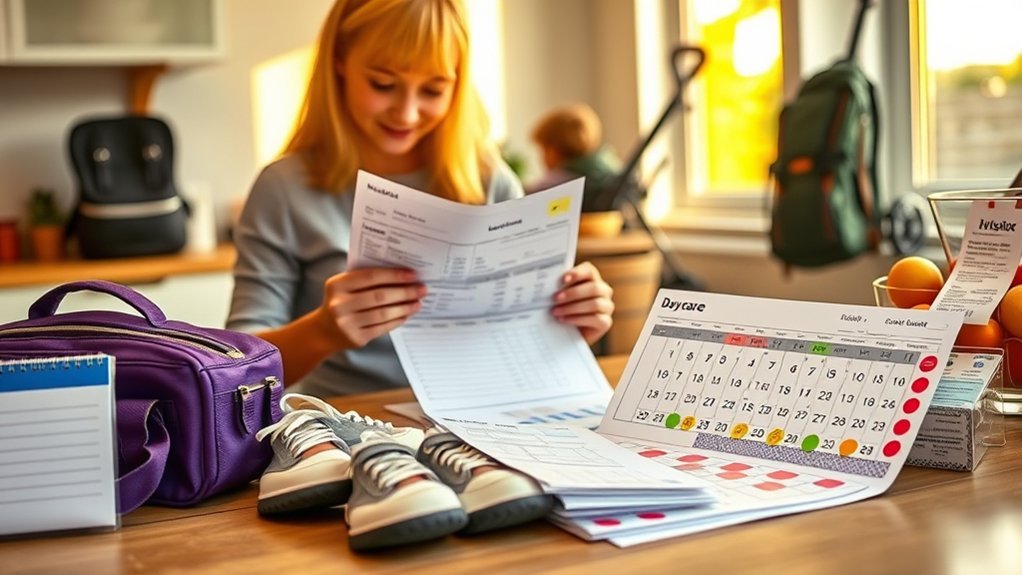
Because raising children in Australia often means juggling high childcare fees and variable schooling costs, you should plan your budget around several cost drivers and available subsidies.
You’ll face day‑care rates nationally from A$70–A$190 per day (average ~A$135), higher in Sydney (~A$150–A$200) and lower in Hobart (~A$90–A$100).
The Child Care Subsidy (CCS) can materially reduce out‑of‑pocket child care spending but is means‑tested and depends on income, activity hours, residency and immunisation.
- Compare day‑care vs family day care: long‑day care averages A$135/day; family day care A$7–A$17/hour.
- Preschool and OSHC: preschool A$45–A$80/day; outside‑school‑hours care A$15–A$45/session.
- Schooling costs: full‑day private preschool ≈ A$2,443/month; international primary fees ≈ A$19,237/year plus uniforms, devices and extracurriculars.
If you’re a family living in Australia, model scenarios with and without CCS to quantify budget impact accurately.
Tips to Reduce Your Cost of Living in Australia
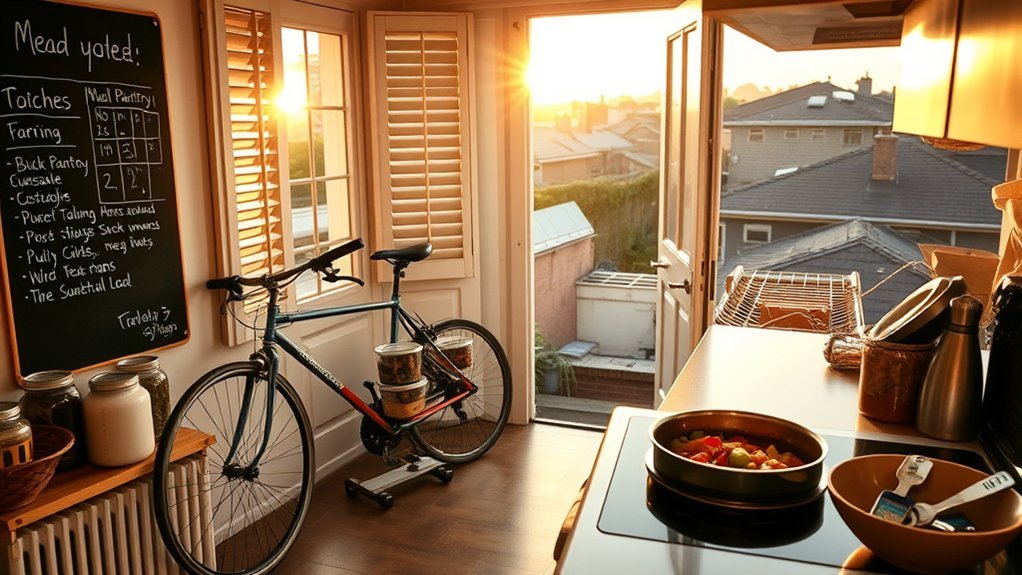
To reduce your overall living costs, focus first on housing and groceries where the largest savings typically appear.
Rent outside major CBDs or share accommodation to cut monthly rent from A$2,236 to A$1,761 for a one‑bedroom on average, and prioritize shopping at ALDI or using Coles/Woolworths loyalty programs to align grocery spending with typical budgets of A$550–A$700 (single) or A$1,000–A$1,300 (family).
Together these changes can shift a substantial portion of your monthly expenses without requiring major lifestyle disruption.
Cut Housing Expenses
Slash your biggest monthly expense by targeting where and how you rent: sharing a 2–3 bedroom flat can cut your per‑person rent by roughly 30–50% versus a solo inner‑city 1‑bed (city average 1‑bed A$2,236; 3‑bed A$3,628), while relocating to regional centres like Bendigo (example family cost A$1,962) or Ballarat (A$1,977) typically yields materially lower rents and greater availability.
You should prioritise flatshare listings on Flatmates, Domain and Realestate to optimise rent per month savings. Negotiate bond and lease terms (12‑month leases reduce turnover risk), verify included utilities, and model commute trade‑offs: a public transport pass (~A$168/month) often costs less than inner‑city rent differentials. Furnish second‑hand via Marketplace or IKEA to minimise upfront expenses.
- Compare city vs regional suburbs rent per month.
- Secure longer lease and confirm bond conditions.
- Buy used furniture; reduce vacancy risk.
Smart Grocery Shopping
Regularly reviewing where and how you buy food can cut your grocery bill materially: shopping at ALDI and local farmers’ markets tends to yield the lowest prices on staples and fresh produce, while using Flybuys/Everyday Rewards and price‑comparison apps like Frugl helps you capture loyalty discounts and targeted deals.
You should shop at stores strategically, comparing unit prices and favouring frozen or in‑season produce to reduce waste.
Use supermarket loyalty programs to earn points on essentials and stack coupons with weekly specials.
Buy in bulk for pantry staples via Costco or bulk bins when unit costs drop materially.
Apply disciplined meal planning and cook at home; it shifts per‑meal costs well below A$25 and can move a single’s groceries toward A$550–A$700/month.
Frequently Asked Questions
How Much Money Do I Need to Live Comfortably in Australia?
You’ll need about A$4,000–5,800/month (single) and A$8,800–9,500/month (family of four) to live comfortably, varying by city and housing; rent typically drives costs, often exceeding 30% of household income.
Is It Better to Live in Australia or the USA?
It depends on your priorities: if you value universal healthcare, stronger public services, and comparable wages, Australia often wins; if you prioritize lower taxes in some states, broader job markets, or varied costs, the USA may suit you better.
How Much Is Monthly Rent in Australia?
Monthly rent in Australia averages about A$2,715 nationally (median), with one‑bedroom city‑centre around A$2,236 and outside A$1,761; three‑bedroom averages A$3,628 city‑centre and A$2,633 outside, varying by city.
Is $10,000 Enough to Move to Australia?
Yes — but don’t expect miracles: A$10,000 typically covers about 2.5 months in a major city or 3–5+ months regionally. You’ll need extra for bonds, furnishing, visas, insurance, and emergency buffers while job hunting.
Conclusion
You’ll find living costs in Australia vary widely by household type—single adults, couples, and families—largely driven by housing. For example, Sydney rent averages about 40% higher than the national median, meaning location can add thousands annually. By focusing on data—rent differentials, utility averages, and childcare fees—you can prioritize savings actions like relocating, budgeting, or negotiating bills to materially reduce expenses while maintaining quality of life.

